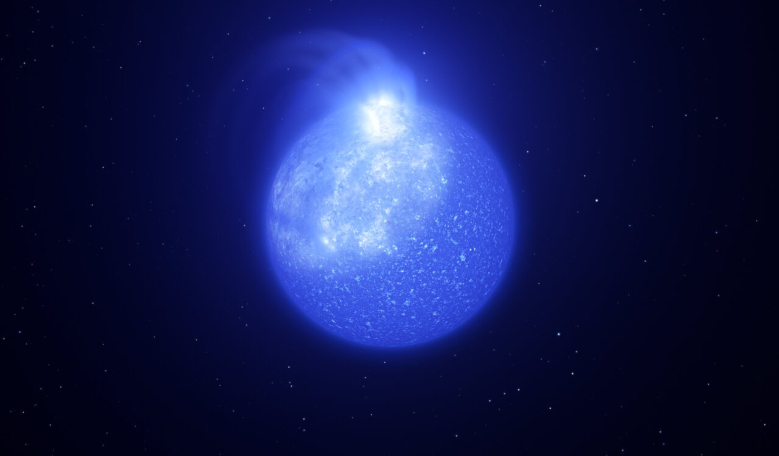The picture of how stars evolve has become a little clearer after astronomers found giant spots made from magnetic fields on the surface of extremely hot and small stars that die prematurely; a finding that could help explain the origin of strong magnetic fields in many white dwarfs.
The single greatest feature that determines how a star lives and dies, is its mass. And depending on what that star’s initial mass is, it will go through a specific evolutionary stage dictated by its internal structure and how it produces energy.
Each of these stages corresponds to a change in the temperature and luminosity of the star, which can be quite handily summarised graphically on a plot known as Hertzsprung-Russell (H-R) diagram.
Developed independently in the early 1900s by Ejnar Hertzsprung and Henry Norris Russell, the diagram plots the temperature of stars against their luminosity, or the colour of stars (or spectral type) against their absolute magnitude.
When stars with intermediate masses (those with masses between 0.8 and 8 solar masses) grow old and become hotter, they move left or roughly horizontal, across the H-R diagram and hence become known as Horizontal Branch stars.
One of the hottest variety of these type of stars is an extreme horizontal branch star (EHB star). These small, super hot stars have temperatures of about 25,000 K and are distinguished from normal horizontal branch stars by having extremely thin, inert hydrogen envelopes surrounding a helium-burning core.
Generally these peculiar hot objects come in pairs, however astronomers have found that when observed in tightly packed stellar groups called globular clusters, the vast majority of EHB stars do not appear to have companions.
Hoping to decipher this and other unusual behaviour of EHB stars, a team of scientists led by Yazan Momany from the INAF Astronomical Observatory of Padua in Italy, used instruments on ESO telescopes, including VIMOS, FLAMES and FORS2, as well as OmegaCAM attached to the VLT Survey Telescope at Paranal Observatory, to study these stars in three different globular clusters in a long-term monitoring programme.
Their observations have revealed that many of the extreme horizontal branch stars within them showed regular changes in their brightness over the course of just a few days to several weeks.
“After eliminating all other scenarios, there was only one remaining possibility to explain their observed brightness variations,” says Simone Zaggia, a study co-author also from INAF: “these stars must be plagued by spots!”
As the hot stars rotate, the spots on the surface come and go, causing the visible changes in brightness.
Spots on extreme horizontal branch stars appear to be quite different though from the dark sunspots on our own Sun.
Although both are caused by magnetic fields, not only are EHB spots significantly larger than sunspots, covering up to a quarter of the star’s surface, they are brighter and hotter than the surrounding stellar surface, unlike on the Sun which are cooler than their surroundings.
EHB spots are also incredibly persistent, lasting for decades. Sunspots on the other hand are temporary, lasting only a few days to months.
In addition to the variations in brightness due to spots, the team also discovered that a couple of EBH stars showed superflare activity — sudden explosions of energy but ten million times more energetic than similar flares seen on our own Sun. This is another indicator that magnetic fields are present.
“Such behaviour was certainly not expected and highlights the importance of magnetic fields in explaining the properties of these stars,” says study co-author Henri Boffin, an astronomer at ESO’s headquarters in Germany.
While these new results help astronomers build a more complete picture of EHB stars, it could also help explain the origin of strong magnetic fields in many white dwarfs; a small very dense star that are typically the size of a planet.
White dwarfs represent the most common endpoint of stellar evolution and more than 95 percent of all stars are expected to end their lives as white dwarfs.
“The bigger picture though,” says team member, David Jones, a former ESO Fellow now at the Instituto de Astrofísica de Canarias, Spain, “is that changes in brightness of all hot stars — from young Sun-like stars to old extreme horizontal branch stars and long-dead white dwarfs — could all be connected. These objects can thus be understood as collectively suffering from magnetic spots on their surfaces.”
These findings have been published today in Nature Astronomy.
If you've enjoyed reading this article, please consider subscribing to ROOM Space Journal to gain immediate and full access to the latest magazine feature articles and receive your own print and/or digital copies of the quarterly ROOM magazine delivered electronically or direct to your door.











